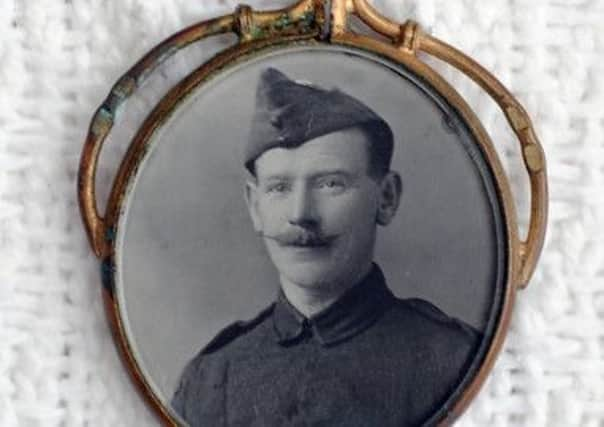Band of ten brothers who went off to war


FOR sisters Noreen Ives and Eileen Walker it started with a couple of pages of fading photographs in a local newspaper.
On August 23, 1916, as part of its weekly photographic record featuring local men who had gone off to fight, the Harrogate Herald published pictures of Richard Bowser and his wife Jeanne Louise, and their 10 sons Albert, George, Tom, Fred, Richard, Percy, Ernest, John ‘Denis’, Frank and Henry Simpson, or ‘HS’ to his family.
Advertisement
Hide AdAdvertisement
Hide AdAccompanying the photographs the newspaper wrote: “We congratulate Mr and Mrs Bowser, of The Avenue, Starbeck, on the rare distinction of having ten sons serving the colours, which will doubtless constitute a record for the district, if not the Empire.” However, its editorial finished on a sombre note, adding: “We regret to announce that one has recently fallen in action.”
Before the war was over two more of the Bowser brothers would join the long list of British troops who never saw their homes and families again.
It is a remarkable family story and for the past three years Noreen and Eileen have been trying to uncover more information about their grandfather Denis and his nine brothers.
“What’s interesting is the older brothers worked as head gardeners. One was with Lady Rothschild, one was a foreman and gardener for Lord Faber and another worked for Lord Curzon at Montague House,” says Noreen, who lives in Ossett, West Yorkshire.
Advertisement
Hide AdAdvertisement
Hide AdThe Bowser family came from Starbeck, near Harrogate, but by the time war broke out the brothers, whose ages ranged from 17 to 35, were scattered all over the world. Several were working in Yorkshire but Henry had emigrated to Canada and Frank was living in Australia.
Nevertheless, by the end of 1915 all the Bowser brothers had enlisted, although because they were living in far flung places it meant they ended up in different regiments. “That in itself is interesting because you would have thought at least a few of them would have gone into the same one,” says Noreen.
Albert joined the West Yorkshire Regiment, while Richard, the eldest, was placed on munitions work at a shell-filling factory. George, a former caddy master at Starbeck Golf course, was a gunner with the Royal Garrison Artillery and Tom took to the air as part of the Royal Naval Flying Corps.
Percy served with the 8th Royal Fusiliers, a London Regiment, and was later awarded the Military Medal for bravery in battle. “Percy survived the war. We know he arrived in France in August 1915 and was awarded several medals. He started out as a private and rose through the ranks to become a corporal and then a second-lieutenant in May 1917.”
Advertisement
Hide AdAdvertisement
Hide AdIn October 1918, just weeks before the war ended, he was awarded the Silver War badge which was given to those forced to leave military service due to wounds, sickness or old age.
Henry Bowser served with the Canadian Engineers having moved to North America in 1911. “We’ve found out that after war was declared he and some comrades walked 70 miles to sign up. He was wounded in France and later he was one of 200 Canadians at a garden party at Buckingham Palace in the presence of Queen Alexandra [Edward VII’s widow] and Queen Amélie of Portugal among many others.”
However, the odds were against all ten brothers surviving the war unscathed and sadly three of them did not make it. Little is known about Frank, a corporal with the Australians, other than the fact he was killed in 1916.
Fred, the youngest, worked as a clerk in a goods warehouse in Starbeck before the war. He joined the Northumberland Fusiliers in Harrogate and trained in the North East before being sent to France.
Advertisement
Hide AdAdvertisement
Hide AdHe died in November 1916 and is among those buried in the British cemetery at Saulty, south west of Arras. He was just 19 years old.
Ernest, a sapper with the Royal Engineers, also lived in Starbeck before the war. He took part in the British campaign in Salonika, in Greece, where they helped the Serbs in their fight against Bulgarian aggression.
But sadly he was killed in the First Battle of Doiran in April 1917. “Apart from Percy they were the three youngest which must have had a terrible effect on their parents.”
The others, though, survived, including Noreen and Eileen’s grandfather Denis, who was with the Royal Flying Corps. “He was a blacksmith by trade to start with and then he became an engineer working in Harrogate before the war. He joined the Flying Corps in 1916 and according to our family history we were told he did fly an aeroplane, but that’s as far as we’ve got,” says Noreen.
Advertisement
Hide AdAdvertisement
Hide Ad“The more you look at it the more you want to find out, but the problem is where to stop because it can become a lifetime’s worth of work.”
They have spent countless hours going through war records and census documents to slowly piece together their family’s wartime story. Today, the names of Fred, Frank and Ernest Bowser are among the 100 that adorn the Starbeck cenotaph, a memorial to those killed during the Great War.
For the sisters it has been a fascinating journey of discovery about their own relatives. “There’s so much we don’t know and this is just going back three generations,” says Noreen.
Eileen agrees. “We thought if we don’t look into this then our history is just going to fade away. We feel we know more about them now – they’ve become actual people, they aren’t just photographs in a newspaper.”